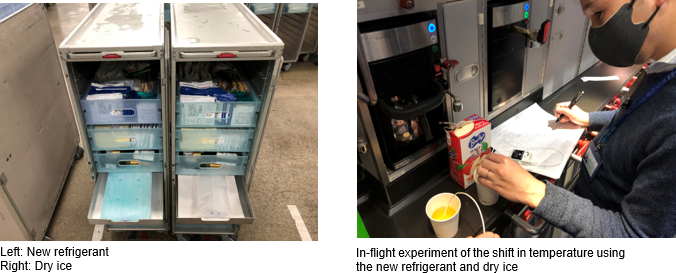Introducing The New Eco-friendly Way to Cool In-Flight Meals and Beverages on Domestic Flights

From September 20, All Nippon Airways (ANA) is adopting a new way to cool in-flight meals and beverages on all domestic flights to reduce CO2 emissions and operating costs.
At ANA, the dry ice traditionally used in the in-flight carts of domestic flights to cool the in-flight meals and beverages lead to an annual CO2 emission of approximately 1,700 tons. From April 2020, ANA began studying the introduction of alternative refrigerants and through testing the cooling effect, temperature maintenance, and impact on the quality of the cooled goods on flights and in regular situations, we decided to switch from dry ice to a new refrigerant.
The newly introduced refrigerant is made of material used as food additives, which is harmless for humans and will help maintain the in-flight meals and beverages at a stable temperature with its capability to maintain cool for a long period of time. In addition, by using the same device repeatedly, the amount of packaging materials used with dry ice will be reduced by about 30 tons per year, which is expected to cut costs by about 200 million yen per year (about 80 percent). Furthermore, as there is less risk of frostbite compared to the handling of dry ice, the new alternative is a sustainable approach for the global environment, economy, and safety.
“This change brings ANA another step closer to achieving our sustainability goals addressed in the ANA Future Promise,” said Junko Yazawa, Senior Vice President overseeing Customer Experience Management & Planning. “It will benefit the environment and reduce costs while ensuring that ANA passengers continue to enjoy quality food and beverages.”
The introduction of the new refrigerant is part of the ANA’s environmental, social and governance (ESG) initiatives embodied in the ANA Future Promise effort to achieve net zero emissions by 2050. ANA has announced the 2050 goal earlier this year in an ambitious update of its 2020 ESG targets. The airline also established new medium-term environmental targets for fiscal 2030 as part of its path to the 2050 benchmark.


























